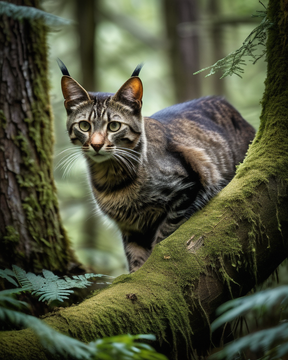- Use a humane trap: Humane traps are designed to safely capture feral cats without causing harm. These traps typically have a door that closes once the cat enters.
- Bait the trap: Use strong-smelling food like tuna, sardines, or wet cat food to entice the feral cat into the trap. Place the bait at the back of the trap to ensure that the cat fully enters.
- Set the trap in a quiet area: Feral cats are often wary of humans, so it's important to set the trap in a quiet and secluded area where the cat feels safe. This will increase the chances of the cat entering the trap.
- Use a laser pointer: Some cats can be guided into a trap with a laser pointer. You can control the laser pointer from a distance and direct it towards the trap, enticing the cat to follow the light and enter the trap.
- Create a feeding routine: Establish a regular feeding routine near the trap. This will help the feral cat associate the trap with a source of food, making it more likely to enter.
- Seek professional help: If you're having difficulty catching feral cats, consider reaching out to local animal welfare organizations or feral cat rescue groups. They may have experienced trappers who can assist you.
Remember, it's important to approach feral cats with caution and prioritize their safety and well-being. Always consult with local authorities or animal welfare organizations for guidance on trapping and handling feral cats.
"In the heart of the dense woodland, a feral cat prowls with the stealth and grace of a natural predator. Its coat, a mosaic of earthy tones, blends seamlessly with the dappled sunlight filtering through the canopy above. The fur, a mixture of dusky browns, tans, and hints of gray, is mottled with patches of darker hues, perfect for camouflaging amidst the shadows and foliage.
Its frame is lean and sinewy, honed by a life of relentless hunting and survival. Muscles ripple beneath its fur as it moves with an effortless litheness, each step calculated and silent upon the forest floor. Its eyes, a piercing amber, gleam with an innate intelligence and a primal instinct that speaks of untamed wilderness.
The cat's ears, adorned with tufts of fur, twitch at the faintest rustle of leaves, attuned to the myriad sounds of the forest. Its whiskers, delicate yet resilient, brush against the undergrowth, sensing the subtlest shifts in the environment. A long, slender tail, tipped with a bushy tuft, sways rhythmically behind it, maintaining balance and conveying its mood with subtle flicks and twitches.
Occasionally, the cat pauses, nostrils flaring as it catches the scent of potential prey or detects the presence of another creature nearby. Its movements become even more cautious, blending into the surroundings like a phantom of the woods. Though wild and untamed, there's a beauty in its primal grace, a testament to the resilience and adaptability of nature's creations."

